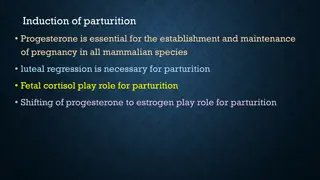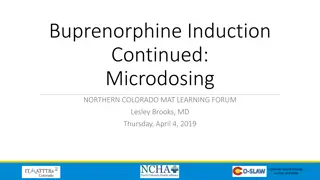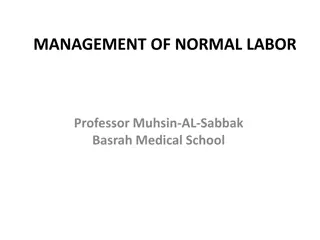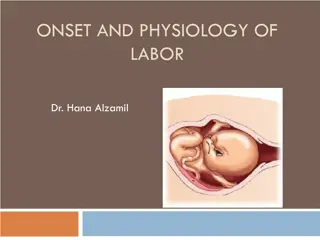Induction of Labor: Methods and Considerations
Induction of labor is done to achieve vaginal delivery before spontaneous onset, usually at 39 weeks or when medically necessary. Risks include failed induction, cesarean section, uterine rupture, prolonged labor, and infections. Cervical ripening methods help prepare the cervix for labor. The Bishop score assesses favorability for inducing labor. Mechanical and medical ripening methods, such as Foley balloon and medications like Misoprostol and Dinoprostol, are used to facilitate the process without increasing risk.
Download Presentation

Please find below an Image/Link to download the presentation.
The content on the website is provided AS IS for your information and personal use only. It may not be sold, licensed, or shared on other websites without obtaining consent from the author. Download presentation by click this link. If you encounter any issues during the download, it is possible that the publisher has removed the file from their server.
E N D
Presentation Transcript
Induction of Labor Berry Campbell, MD
Induction of Labor Goal: achieve a vaginal delivery by inducing contractions before spontaneous onset of labor When? 39 weeks OR when medically indicated (preeclampsia, FGR, etc) Risks? Failed induction and cesarean section; uterine rupture; prolonged labor and chorioamnionitis, pp hemorrhage, endometritis
Cervical ripening Facilitate cervix softening, thinning, dilatation to reduce failed inductions and shorten induction to delivery time Attempt to mimic the natural process of cervix remodeling: collagen breakdown, increase cytokines when unfavorable cervix
Bishop score 6 score is considered unfavorable > 8 score, the probability of vaginal delivery after IOL is similar to spontaneous labor When unfavorable, methods to make cervix favorable ( ripen ) used
Ripening methods Mechanical: Hygroscopic Osmotic dilators (laminaria) Foley balloon Medical: Misoprostol (PGE1) Dinoprostol (PGE2) Oxytocin
Foley balloon/Cook balloon system Inexpensive Effective May use with oxytocin No increased risk tachysystole
Misoprostol (PGE1) Approved to treat gastric ulcers Works extremely well to soften, efface and dilate Inexpensive 100 mcg pills split to 25 mcg doses: administer q 3-6 hours Equally effective orally OR vaginally; Sublingual also used SE: uterine tachysystole with or without FHR changes (IVF, position changes, SQ terbutaline) Less tachysystole/FHR abnormalities with oral administration Contraindicated with prior uterine scar
Dinoprostol (PGE2) Intracervical, intravaginal gel 0.5 mg (q 6-12 hours, 3 doses) or vaginal insert (depot with 10 mg, slow release-one every 12 hours) Equally effective as misoprostol Much more expensive Lower risk of tachysystole if occurs, can remove the insert Contraindicated with prior uterine scar
IOL Oxytocin is the mainstay Intravenous initial response 3-5 minutes, steady state after 40 minutes Low dose, high dose protocols institution based (1x1x30; 4x4x15) More responsive with advancing GA plateau at 32 weeks-term. Most effective with favorable cervix Goal ctx every 2-3 minutes (tachysystole is >5 ctx/10 min averaged over 30 minutes)
IOL Other Stripping of membranes: requires some dilatation, increases likelihood of labor within 48 hours
IOL Other Amniotomy: Adjunct to enhance labor with favorable cervix Not necessarily as effective alone w/o ctx and/or oxytocin Nipple stimulation: Adjunct to enhance labor with favorable cervix
ARRIVE Trial N= 6106 randomized low risk G1 at 41 facilities 39 week induction vs expectant Primary outcomes: PNM&M no difference; CS rate lower in induction group (18.6 vs 22.2%) Secondary outcomes: Induction lower GHTN/preecl rate (9.1 vs 14.1%); lower need for neonatal support. No difference among any ethnic, racial groups NEJM Aug 8, 2018
ARRIVE Trial Offering elective IOL at 39 weeks should take into account: Pt preference Resources available (including personnel)and space Allow longer latent phases (up to 24 hours+) Use oxytocin for 18 hours after ROM before calling failed induction
Analysis of Obstetric Outcomes by Hospital Location, Volume, and Teaching Status Associated With Non Medically Indicated Induction of Labor at 39 Weeks JAMA Open. Hersh, AR st al 2023; 6 (4): e239167 N= 24,272 nonmedically IOL Lower CS rates with induction in medium and large hospital delivery services; no difference in small hospitals Chorioamnionitis and pp hemorrhage lower in IOL group Neonatal outcomes better in IOL group
IOL Special considerations Management of fetal demise Management of fetal demise in the mid-trimester with and without uterine scar --High dose oxytocin --High dose misoprostol























